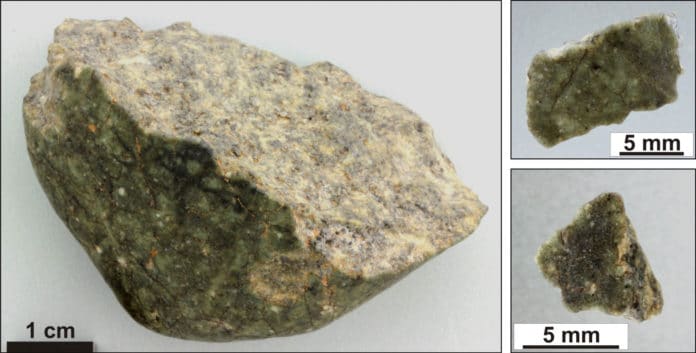European scientists have discovered a new high-pressure mineral donwilhelmsite from the moon in a lunar meteorite. It is the first high-pressure mineral found in meteorites with the application for terrestrial sediments dragged deep into the Earth mantle by plate tectonics. The discovery of the mineral could help explain what happens to materials within the extreme pressures of the Earth’s mantle.
The donwilhelmsite is consists of calcium, aluminum, silicon, and oxygen atoms. It was discovered within the lunar meteorite Oued Awlitis 001, found in 2014 in Western Sahara.
In the terrestrial rock cycle, donwilhelmsite is an essential agent for transporting continental crustal sediments through the transition zone of the Earth’s mantle (460-700 km depth).
The Apollo and Luna missions have gathered around 382 kilograms of rocks and soil; lunar meteorites allow valuable knowledge into the moon’s formation and evolution. Ejected by impacts onto the lunar surface and delivered to Earth, some of these meteorites experienced especially high temperatures and pressures.
Dr. Vera Assis Fernandes of The University of Manchester measured the Argon isotopic composition of lunar rocks to date their complicated history, including magmatic formation, multiple impact bombardments, and cosmic exposure rays on the lunar surface over billions of years.
She also determined the ages of various events in this meteorite’s complex history, including the formation of the new mineral donwilhlemsite.
Dr. Fernandes emphasized, “During impact bombardment, rocks like the lunar meteorite Oued Awlitis 001 experience extreme physical conditions. This often led to shock melting of microscopic areas forming veins or melt pockets within these meteorites.”
“These shocking areas are of great relevance as they mirror pressure and temperature regimes similar to those prevailing in the Earth’s mantle, and therefore are natural crucibles hosting minerals that are otherwise naturally inaccessible at the Earth’s surface.”
Using the 3-D electron diffraction (3DED) technique, scientists determined an extraterrestrial mineral’s crystal structure. The new mineral was named in honor of the lunar geologist Don E. Wilhelms, an American scientist involved in landing site selection and data analyses of the Apollo space missions that brought Earth the first rock samples from the moon. Part of the meteorite Oued Awlitis 001 is now on display at the Natural History Museum Vienna.
Journal Reference:
- Jörg Fritz et al. Donwilhelmsite, [CaAl4Si2O11], a new lunar high-pressure Ca-Al-silicate with relevance subducted terrestrial sediments, American Mineralogist (2020). DOI: 10.2138/am-2020-7393
